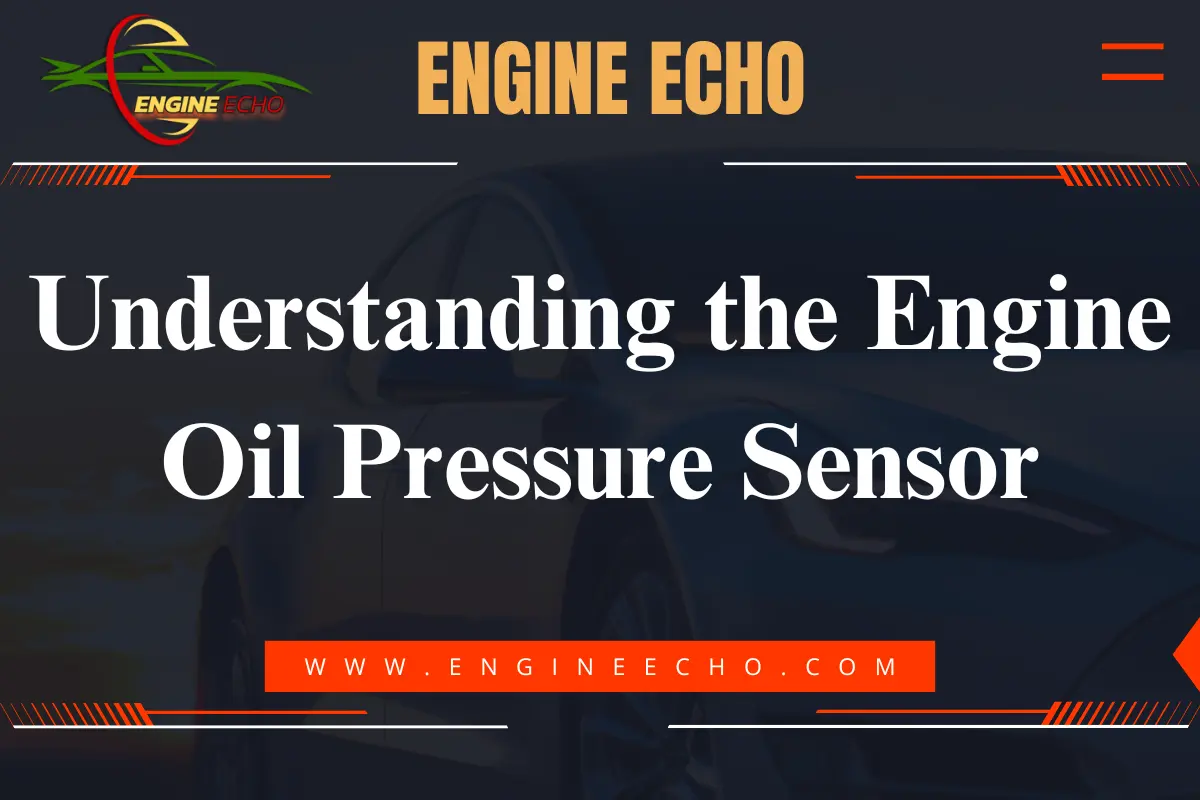Understanding the Engine Oil Pressure Sensor

Key Takeaways:
- The engine oil pressure sensor is small but plays a big role in keeping your engine running smoothly.
- It alerts you to oil pressure problems before they turn into major engine damage.
- If the sensor’s faulty, you’ll get inaccurate readings, which can lead to costly repairs if not fixed.
- Regularly checking and maintaining the sensor can extend the life of your engine.
- Replacing a bad sensor on time can save you a lot of stress and money down the road.
Introduction
Engine issues have a way of creeping up on you, and I can tell you from experience—ignoring a faulty oil pressure sensor is one mistake you don’t want to make. It might seem like just a little warning light on the dashboard, but that tiny sensor could save you from major engine trouble. Let’s dive into what an engine oil pressure sensor does, how it works, and why it deserves your attention.
1. What is an Engine Oil Pressure Sensor?
It’s easy to overlook this tiny sensor, but trust me, it plays a huge role in keeping your engine happy. The sensor keeps an eye on your oil pressure and sends real-time data to your dashboard. When it detects something’s off, it’ll trigger a warning light. Without it, you’re essentially flying blind when it comes to knowing if your engine’s getting the lubrication it needs.
- Personal Take: I’ve seen this little gadget get neglected too many times. It might not be exciting, but it’s critical. When it fails, it usually brings along a lot of headaches.
2. How the Engine Oil Pressure Sensor Works
The sensor is like your engine’s watchdog, always on the lookout for low oil pressure, and gives you a heads-up when things aren’t quite right. It sends a signal to your car’s computer or dashboard, and when the pressure drops below safe levels, you’ll get a warning light.
- My Experience: I remember the first time my oil pressure light flickered. I shrugged it off, thinking it was just a glitch. A week later, I was dealing with a hefty repair bill—turns out it wasn’t just a glitch after all.
3. Types of Oil Pressure Sensors
There are two main types of oil pressure sensors: mechanical and electrical. Each type has its own role depending on the vehicle you drive.
Mechanical Sensors
- These are common in older cars and directly connect to an oil line to register pressure changes. They’re simple, but over time, they can wear out.
Electrical Sensors
- Found in most modern cars, these sensors electronically monitor the oil pressure. They’re more accurate and reliable, making them a better fit for today’s complex engines.
4. Role of the Oil Pressure Sensor in Engine Health
Think of the oil pressure sensor as your engine’s way of communicating with you. When things are running smoothly, you won’t hear a peep from it. But when it senses low pressure, it’s like the engine is waving a red flag, saying, “Hey, I need more oil!”
- Personal Insight: I’ve been guilty of ignoring that red flag in the past. A warning light is easy to dismiss, but trust me—it’s worth taking seriously. It could be the difference between a quick fix and a major engine repair.
5. Symptoms of a Faulty Oil Pressure Sensor
If your oil pressure sensor is acting up, it won’t stay quiet. You’ll notice a few signs, and it’s best to catch them early.
- Dashboard Warning Light: If your oil pressure light keeps coming on even though your oil levels are fine, your sensor might be on its way out.
- Inconsistent Readings: Erratic or fluctuating oil pressure readings that don’t match how the engine feels can also point to a faulty sensor.
- Oil Leaks: Oil leaking around the sensor is another red flag that something’s wrong.
- My Experience: One time, I ignored a flickering oil pressure light, thinking it was just a sensor glitch. That turned into an expensive lesson when my engine ended up needing repairs that could’ve easily been avoided.
6. Common Causes of Oil Pressure Sensor Failures
There are a few common reasons why your oil pressure sensor might fail, and catching these early is key to preventing bigger issues.
Electrical Issues
- Corroded or loose wiring can lead to faulty readings. Over time, connections can break down, causing sensor malfunctions.
Mechanical Wear
- Like anything under the hood, the sensor will wear out over time. Continuous heat and pressure exposure can take a toll on its components.
7. Diagnosing a Faulty Oil Pressure Sensor
If your sensor seems a little off, don’t wait for it to turn into a bigger problem. There are some easy ways to check what’s going on with your sensor so you can fix it before it becomes a bigger issue.
- Tools Needed: You’ll need a diagnostic scanner and a mechanical oil pressure gauge.
- Step-by-Step Diagnosis:
- Check if the warning light is accurate by comparing the oil levels manually.
- Use a diagnostic tool to check for any error codes that could indicate a sensor problem.
- Use a manual gauge to measure the actual oil pressure and compare it to the sensor’s readings.
- Recommendation: From my experience, doing a quick diagnostic check can save you from major engine headaches. If the sensor’s giving weird readings, don’t wait—get it checked out before it causes real damage.
8. How to Replace an Engine Oil Pressure Sensor
Replacing the sensor isn’t too complicated, and if you’re comfortable with basic tools, you can do it yourself. Here’s how:
Preparation
- Tools Needed: A wrench, a new oil pressure sensor, and thread sealant.
- Safety Tip: Always make sure the engine is cool before starting work on it.
Step-by-Step Replacement:
- Disconnect the negative battery terminal to avoid any electrical issues.
- Locate the oil pressure sensor, usually near the oil filter or on the engine block.
- Unplug the electrical connector from the sensor.
- Use a wrench to remove the old sensor.
- Apply thread sealant to the new sensor and install it.
- Reconnect the sensor and the battery.
- My Experience: I’ve replaced a sensor myself before, and it’s not as complicated as it sounds. If you’ve got the tools and some patience, you can do it without needing to call in a mechanic.
9. Benefits of Regular Maintenance and Replacement
Taking care of your oil pressure sensor might seem like a small thing, but it makes a huge difference for your engine. Here’s why:
- Longer Engine Life: A healthy sensor ensures your engine stays properly lubricated, which helps reduce wear and tear.
- Cost-Effective: Replacing a faulty sensor early on can prevent much more expensive engine repairs later.
- Recommendation: I can’t stress this enough—regular maintenance is key. I’ve seen how ignoring something small like a sensor can turn into a big problem. Take care of it, and your engine will thank you.
10. The Relationship Between Oil Pressure and Engine Performance
Oil pressure affects just about everything in your engine. Low oil pressure can reduce fuel efficiency, cause overheating, and even lead to total engine failure.
- Optimal Performance: Maintaining the right oil pressure keeps everything running smoothly and prevents overheating.
- Fuel Efficiency: Poor lubrication forces your engine to work harder, which means you’re wasting fuel.
- Personal Take: If you care about your car’s performance—whether you’re driving to work or hitting the track—don’t ignore oil pressure. I’ve felt the difference when things aren’t right, and it’s not worth the risk.
11. Case Studies: Real-world Examples of Oil Pressure Sensor Failures
Example 1: Ignoring the Warning Light
A buddy of mine once thought his oil pressure warning light was just a glitch. He ignored it, and a few weeks later, his engine overheated and seized, costing him thousands in repairs.
Example 2: Timely Replacement Saves the Day
I had a similar experience, but I replaced the faulty sensor right away. That quick decision saved me from what could have been a major engine failure—and a massive repair bill.
12. Conclusion
This tiny sensor might seem like no big deal, but it’s crucial if you want to keep your engine running smoothly. Take care of it, and it’ll save you from expensive repairs and extend the life of your car. Trust me, it’s worth paying attention to.
FAQs
Q1: How long does an engine oil pressure sensor last?
Your oil pressure sensor should last about 60,000 to 100,000 miles, but how long it lasts really depends on how you drive and take care of your car.
Q2: Can I drive with a faulty oil pressure sensor?
It’s not a good idea. A bad sensor might give you false readings, and if you miss real low oil pressure, it could seriously damage your engine.
Q3: What happens if I ignore an oil pressure warning light?
Ignoring the oil pressure warning light can lead to severe engine damage, like overheating or complete engine failure, which means expensive repairs.
Q4: How often should the oil pressure sensor be replaced?
You should check the sensor during regular maintenance, and replace it if it’s faulty or if your car’s manufacturer recommends doing so.
Q5: How much does it cost to replace an engine oil pressure sensor?
It usually costs between $100 and $200 to replace the sensor, depending on your car model and where you get it done.
Thanks for checking out this article on EngineEcho.com! Hope you found this article: "Understanding the Engine Oil Pressure Sensor" helpful! If you liked it and want to dive into more car engine topics, head over to our homepage. There's always something new to discover in the world of engines. Enjoy your reading journey!
Check out our previous article: M120 Engine: Mercedes' V12 Masterpiece






